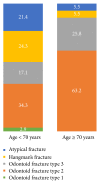C2 Fracture Subtypes, Incidence, and Treatment Allocation Change with Age: A Retrospective Cohort Study of 233 Consecutive Cases
- PMID: 28182084
- PMCID: PMC5274671
- DOI: 10.1155/2017/8321680
C2 Fracture Subtypes, Incidence, and Treatment Allocation Change with Age: A Retrospective Cohort Study of 233 Consecutive Cases
Abstract
The currently available data on the distribution of C2 fracture subtypes is sparse. This study was designed to identify the proportions of the second cervical vertebra (C2) fracture subtypes and to present age and gender specific incidences of subgroups. A dataset of all patients treated between 2002 and 2014 for C2 fractures was extracted from the regional hospital information system. C2 fractures were classified into odontoid fractures types 1, 2, and 3, Hangman's fractures types 1, 2, and 3, and atypical C2 fractures. 233 patients (female 51%, age 72 ± 19 years) were treated for a C2 fracture. Odontoid fractures were found in 183 patients, of which 2 were type 1, 127 type 2, and 54 type 3, while 26 of C2 fractures were Hangman's fractures and 24 were atypical C2 fractures. In the geriatric subgroup 89% of all C2 fractures were odontoid, of which 71% were type 2 and 29% type 3. There was an increasing incidence of odontoid fractures types 2 and 3 from 2002 to 2014. 40% of C2 fractures were treated surgically. This study presents reliable subset proportions of C2 fractures in a prospectively collected regional cohort. Knowledge of these proportions facilitates future epidemiological studies of C2 fractures.
Conflict of interest statement
The authors declare that they have no competing interests.
Figures




References
-
- Pepin J. W., Bourne R. B., Hawkins R. J. Odontoid fractures, with special reference to the elderly patient. Clinical Orthopaedics and Related Research. 1985;193:178–183. - PubMed
MeSH terms
LinkOut - more resources
Full Text Sources
Other Literature Sources
Medical
Miscellaneous

